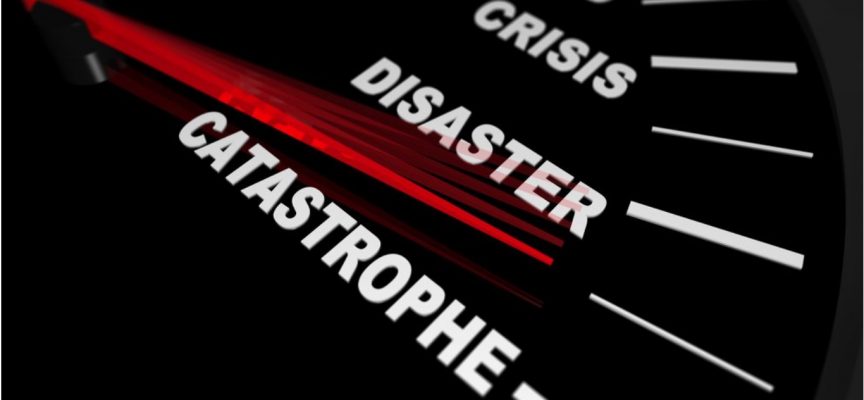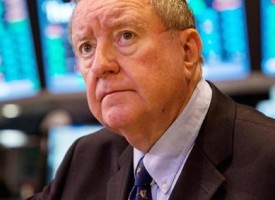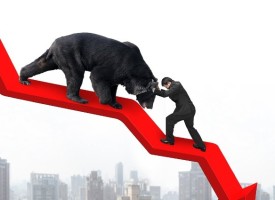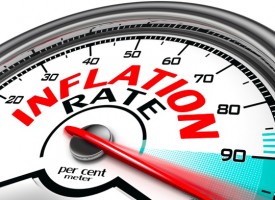This is an important look at the greatest crisis facing the world and why gold will have a vital role in the new monetary system.
The Future Could Be A Lot Brighter
September 26 (King World News) – Dr. Stephen Leeb: The rally in commodities over the last year and longer has been one of the strongest and most all-encompassing ever. The fact that it has gone hand in hand with lackluster performance in gold and silver is a disturbing sign that the world currently is moving in the wrong direction, making choices with potentially devastating outcomes.
Those outcomes could include a future in which soaring commodities go along with sharply declining living conditions – stagflation on steroids. A future that might feature a depression of historic magnitude in the West and a sharp slowdown in the East. Or to get really apocalyptic, even all-out war in which population sizes ultimately determine who emerges with relatively less damage, as described by Walter Scheidel in his modern classic The Great Leveler: Violence and the History of Inequality from the Stone Age to the Twenty-First Century. And finally, a future in which, by focusing on the wrong threat, we’ve shortsightedly made it impossible to ever achieve a sustainable world that runs on renewable energies.
But if we get on a different path by making different choices, the future could be a lot brighter. That, however, will require doing things that fly in the face of current policies and beliefs. For starters, it means that the U.S. and other countries need to emphasize cooperation rather than competition and conflict, coming together in a common quest get to a renewable world.
It also means, and I know how controversial this is, being willing to revise the global consensus that it’s climate change that is the existential threat. It’s not – the greater threat is resource scarcities. Both threats point alike to the urgent need to transition to a sustainable world that is run by renewable energies. But only by focusing on resource scarcities do we have a hope of getting to that world.
Sounding The Alarm
It’s critical for the world to grasp the true nature and magnitude of the challenges we face. I’m doing my best to sound the alarm in these interviews and in my latest book China’s Rise and the New Age of Gold.
Whatever happens, though, you need to own gold. If the world doesn’t change course, gold will be the one investment you can count on to protect you. And if the world does get onto a more sustainable path, the gains in gold will likely be stupendous, because that sustainable path will need to be underlaid by a new inclusive monetary system backed by gold.
Slow Down Activists, We Need Carbon Based Energy
Such a monetary system will require tremendous cooperation among the world’s leading economies. The U.S., which right now is trying to protect the dollar’s role as the world’s main reserve currency, will need to accept a lesser role for the greenback. And all countries will need to accept that to ever get to a world that runs on renewable energies, the fight against climate change will need to take place over a longer time frame than is currently envisioned.
The belief that climate change and global warming are the existential threats to the world is taken by much of the world as scientific gospel. And I have no problem with many of the policies that come into play, from gas mileage standards to anything that increases energy efficiency. The problem I have is with policies that aim to suppress or de-incentivize carbon, because in the transition to renewable energies, in order to carry out that transition, we are going to need all the energy we can get, including from carbon sources.
I’m sure everyone knows the fable The Emperor’s New Clothes. The Hans Christian Andersen version was published in 1837, but similar stories go back at least to the 11th century, illustrating that it’s a timeless human trait to fall prey to self-delusion and to crowd psychology. Today I believe that applies to the belief that climate change is the biggest threat – when the actual biggest threat is resource scarcity. Ironically, an all-out effort against climate change drastically lessens our chances of transitioning to renewable energies, a transition that is the ultimate solution to creating a sustainably livable world. Fervent believers in the primacy of climate change are putting too much faith in scientific models that, as I discuss below, are more fallible than is generally acknowledged….
Listen to the greatest Egon von Greyerz audio interview ever
by CLICKING HERE OR ON THE IMAGE BELOW.
Current trends in energy show what we’re risking. As Bloomberg energy writer Julian Lee recently reported, natural gas stockpiles in Europe are low just as winter is coming on. Energy prices have been surging with an intense and sometimes surprising circularity, as gains in one source dramatically reinforce gains in another.
For example, natural gas, the lowest carbon producer among fossil fuels, has been replacing coal, which is the highest carbon producer. Using less carbon is also motivated by Europe’s carbon market also has incentivized lower use of carbon, as carbon prices have surged by over 60% since the beginning of 2021.
Coal production, because of its high carbon footprint, has been sharply constrained, though worldwide it is still the leading energy source for producing electricity and plays a major role in industrial applications. In the past 12 months, according to Bloomberg, Newcastle coal, one of the major sources of Asian coal, has risen from less than $90 a ton to $180 a ton. That’s not an anomaly: prices throughout Asia have risen by similar amounts. Europeans who have been shuttering their coal production and increasing imports have witnessed a doubling in the price of imported coal
Further exacerbating these trends, especially in Europe, is the price of carbon. Carbon trading originated in Europe about 15 years ago as a way of incentivizing a lower carbon footprint. Since the beginning of 2021, carbon prices have surged by about 80% – the higher these prices, the greater the penalty for using high-carbon fuels. It’s another factor driving demand for, and prices of, low-carbon fuels as well as the prices of supply- limited high-carbon coal. Everything, after all depends on energy, and higher prices for one source will affect other sources as well.
Oil is a critical industrial commodity and remains, by a wide margin, the most important transportation fuel. Both coal and oil have major industrial uses. You can’t make steel, for example, without ample amounts coal and oil byproducts.
Renewable energies have felt the impact. Solar panel prices are rising for the first time since China entered the market in a big way about a decade ago. Solar panels, in addition to their sophisticated technology, require ultrapure silicon known as polysilicon. Remember the old commercials that claimed that Ivory soap was 99.9% pure? The polysilicon in solar panels has to be 99.9999% pure. China produces 90% of the world’s polysilicon. One reason for this near-monopoly position is the country’s access to cheap energy. Producing polysilicon is energy-intensive, and higher energy prices are making solar panels more expensive. The dramatic drop in solar prices over the past 15 years had inspired such hope. Now, no matter what index you use, solar wafer prices are rising and are up about 80% so far this year.
The recent energy crunch isn’t a one-off event but rather reflects efforts to reduce humanity’s carbon footprint. Unfortunately, with carbon-based fuels accounting for nearly 80% of the world’s energy supply, and energy vitally needed to build out renewables, draconian efforts to limit carbon will backfire and turn into an existential threat more credible than climate change. Given the lead times to bring on new energy supplies of any kind, whether fossil fuels or renewables, plus the lead times to bring on new and hopefully cheaper mines of critical commodities, which themselves are used to produce energy, it is unavoidable that we’ll reach a tipping point where our good intentions result in catastrophe.
Questioning Climate Change
Now a quick look at why I believe that a go-slower approach to climate change won’t lead to the kind of disaster the world has accepted as gospel. I’ve referred before to Steven Koonin’s book Unsettled. Koonin is the opposite of the kind of knee-jerk anti-science typically seen as questioning the science behind climate models. During the Obama administration he served in the Energy Department as undersecretary of science. He also has chaired JASON, an advisory body created in the aftermath of Sputnik to advise the government on a wide range of science-related issues and whose members since have included 11 Nobel laurates.
Koonin’s book is a wake-up call, but it isn’t a polemic. It simply presents the uncertainties surrounding the science of climate change and concludes that we could surmount even the most rapid rise in temperature envisioned. On p.180, for example, he presents a chart of changes in GDP that would result from various scenarios. In a worst-case scenario in which the climate has warmed by 9 degrees Fahrenheit by 2090, lost growth would amount to two years. In other words, it would take 70 years to achieve current economic growth projections rather than 68. This assessment is based on U.N. data and is nearly identical to data from major climate groups. On the same page, Koonin says he was “dumbfounded” when he asked a prominent (unnamed) environmentalist about the U.N. findings. His reply was: “Yes, it’s unfortunate the impact numbers are so small.”
Koonin’s Book Shadow Banned?
I think Unsettled should be mandatory reading for climate activists and anyone involved in climate policy – though getting hold of it might take some doing. I’m not generally conspiracy-minded, but I find it curious that after the book was released – and became an instant bestseller, with the first printing selling out quickly – it suddenly took a month to get a copy from Amazon, even though reprintings typically take mere days.
Gold Will Have A Vital Role In The New Monetary System
I’ll conclude by again urging that you buy gold. and indeed, other commodities as well. And as long as I’ve brought up the notion of conspiracies, paper gold can be and is suppressed from by central banks. For obvious reasons, the U.S. hates gold right now. But a new monetary system is inevitable, and in the end will benefit everyone, including the United States. Gold will have a vital role in that monetary system, and any volatility in gold prices over the nearer term should be taken as a great buying opportunity – possibly the last one that you’ll get.
***To listen to Stephen Leeb discuss what to expect next in the gold and silver markets as well as a global game-changer CLICK HERE OR ON THE IMAGE BELOW.
***To listen to this timely audio interview about what is going to have a huge impact on the gold and silver markets going forward CLICK HERE OR ON THE IMAGE BELOW.
© 2021 by King World News®. All Rights Reserved. This material may not be published, broadcast, rewritten, or redistributed. However, linking directly to the articles is permitted and encouraged.










